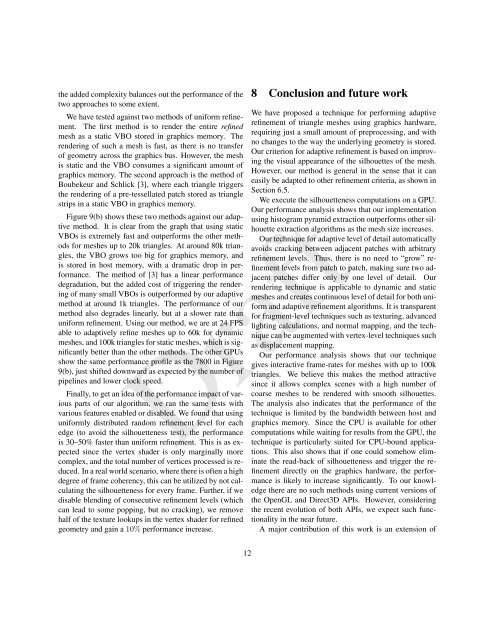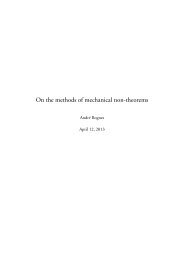Real-Time GPU Silhouette Refinement using adaptively blended ...
Real-Time GPU Silhouette Refinement using adaptively blended ...
Real-Time GPU Silhouette Refinement using adaptively blended ...
You also want an ePaper? Increase the reach of your titles
YUMPU automatically turns print PDFs into web optimized ePapers that Google loves.
the added complexity balances out the performance of the<br />
two approaches to some extent.<br />
We have tested against two methods of uniform refinement.<br />
The first method is to render the entire refined<br />
mesh as a static VBO stored in graphics memory. The<br />
rendering of such a mesh is fast, as there is no transfer<br />
of geometry across the graphics bus. However, the mesh<br />
is static and the VBO consumes a significant amount of<br />
graphics memory. The second approach is the method of<br />
Boubekeur and Schlick [3], where each triangle triggers<br />
the rendering of a pre-tessellated patch stored as triangle<br />
strips in a static VBO in graphics memory.<br />
Figure 9(b) shows these two methods against our adaptive<br />
method. It is clear from the graph that <strong>using</strong> static<br />
VBOs is extremely fast and outperforms the other methods<br />
for meshes up to 20k triangles. At around 80k triangles,<br />
the VBO grows too big for graphics memory, and<br />
is stored in host memory, with a dramatic drop in performance.<br />
The method of [3] has a linear performance<br />
degradation, but the added cost of triggering the rendering<br />
of many small VBOs is outperformed by our adaptive<br />
method at around 1k triangles. The performance of our<br />
method also degrades linearly, but at a slower rate than<br />
uniform refinement. Using our method, we are at 24 FPS<br />
able to <strong>adaptively</strong> refine meshes up to 60k for dynamic<br />
meshes, and 100k triangles for static meshes, which is significantly<br />
better than the other methods. The other <strong>GPU</strong>s<br />
show the same performance profile as the 7800 in Figure<br />
9(b), just shifted downward as expected by the number of<br />
pipelines and lower clock speed.<br />
Finally, to get an idea of the performance impact of various<br />
parts of our algorithm, we ran the same tests with<br />
various features enabled or disabled. We found that <strong>using</strong><br />
uniformly distributed random refinement level for each<br />
edge (to avoid the silhouetteness test), the performance<br />
is 30–50% faster than uniform refinement. This is as expected<br />
since the vertex shader is only marginally more<br />
complex, and the total number of vertices processed is reduced.<br />
In a real world scenario, where there is often a high<br />
degree of frame coherency, this can be utilized by not calculating<br />
the silhouetteness for every frame. Further, if we<br />
disable blending of consecutive refinement levels (which<br />
can lead to some popping, but no cracking), we remove<br />
half of the texture lookups in the vertex shader for refined<br />
geometry and gain a 10% performance increase.<br />
8 Conclusion and future work<br />
We have proposed a technique for performing adaptive<br />
refinement of triangle meshes <strong>using</strong> graphics hardware,<br />
requiring just a small amount of preprocessing, and with<br />
no changes to the way the underlying geometry is stored.<br />
Our criterion for adaptive refinement is based on improving<br />
the visual appearance of the silhouettes of the mesh.<br />
However, our method is general in the sense that it can<br />
easily be adapted to other refinement criteria, as shown in<br />
Section 6.5.<br />
We execute the silhouetteness computations on a <strong>GPU</strong>.<br />
Our performance analysis shows that our implementation<br />
<strong>using</strong> histogram pyramid extraction outperforms other silhouette<br />
extraction algorithms as the mesh size increases.<br />
Our technique for adaptive level of detail automatically<br />
avoids cracking between adjacent patches with arbitrary<br />
refinement levels. Thus, there is no need to “grow” refinement<br />
levels from patch to patch, making sure two adjacent<br />
patches differ only by one level of detail. Our<br />
rendering technique is applicable to dynamic and static<br />
meshes and creates continuous level of detail for both uniform<br />
and adaptive refinement algorithms. It is transparent<br />
for fragment-level techniques such as texturing, advanced<br />
lighting calculations, and normal mapping, and the technique<br />
can be augmented with vertex-level techniques such<br />
as displacement mapping.<br />
Our performance analysis shows that our technique<br />
gives interactive frame-rates for meshes with up to 100k<br />
Draft<br />
Draft<br />
triangles. We believe this makes the method attractive<br />
since it allows complex scenes with a high number of<br />
coarse meshes to be rendered with smooth silhouettes.<br />
The analysis also indicates that the performance of the<br />
technique is limited by the bandwidth between host and<br />
graphics memory. Since the CPU is available for other<br />
computations while waiting for results from the <strong>GPU</strong>, the<br />
technique is particularly suited for CPU-bound applications.<br />
This also shows that if one could somehow eliminate<br />
the read-back of silhouetteness and trigger the refinement<br />
directly on the graphics hardware, the performance<br />
is likely to increase significantly. To our knowledge<br />
there are no such methods <strong>using</strong> current versions of<br />
the OpenGL and Direct3D APIs. However, considering<br />
the recent evolution of both APIs, we expect such functionality<br />
in the near future.<br />
A major contribution of this work is an extension of<br />
12
















